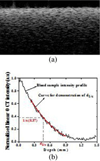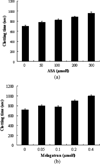Evaluation of optical coherence tomography for the measurement of the effects of activators and anticoagulants on the blood coagulation in vitro
- PMID: 23392340
- PMCID: PMC3888882
- DOI: 10.1109/TBME.2013.2245329
Evaluation of optical coherence tomography for the measurement of the effects of activators and anticoagulants on the blood coagulation in vitro
Abstract
Optical properties of human blood during coagulation were studied using optical coherence tomography (OCT) and the parameter of clotting time derived from the 1/e light penetration depth (d(1/e)) versus time was developed in our previous work. In this study, in order to know if a new OCT test can characterize the blood-coagulation process under different treatments in vitro, the effects of two different activators (calcium ions and thrombin) and anticoagulants, i.e., acetylsalicylic acid (ASA, a well-known drug aspirin) and melagatran (a direct thrombin inhibitor), at various concentrations are evaluated. A swept-source OCT system with a 1300 nm center wavelength is used for detecting the blood-coagulation process in vitro under a static condition. A dynamic study of d1/e reveals a typical behavior due to coagulation induced by both calcium ions and thrombin, and the clotting time is concentration-dependent. Dose-dependent ASA and melagatran prolong the clotting times. ASA and melagatran have different effects on blood coagulation. As expected, melagatran is much more effective than ASA in anticoagulation by the OCT measurements. The OCT assay appears to be a simple method for the measurement of blood coagulation to assess the effects of activators and anticoagulants, which can be used for activator and anticoagulant screening.
Figures






Similar articles
-
Effect of fibrinogen on blood coagulation detected by optical coherence tomography.Phys Med Biol. 2015 May 21;60(10):4185-95. doi: 10.1088/0031-9155/60/10/4185. Epub 2015 May 8. Phys Med Biol. 2015. PMID: 25955503
-
Optical coherence tomography to investigate optical properties of blood during coagulation.J Biomed Opt. 2011 Sep;16(9):096002. doi: 10.1117/1.3615667. J Biomed Opt. 2011. PMID: 21950916
-
Monitoring the blood coagulation process under various flow conditions with optical coherence tomography.J Biomed Opt. 2014 Apr;19(4):046021. doi: 10.1117/1.JBO.19.4.046021. J Biomed Opt. 2014. PMID: 24781589
-
A step change in oral anticoagulation: lack of coagulation monitoring with ximelagatran.Semin Vasc Med. 2005 Aug;5(3):259-65. doi: 10.1055/s-2005-916165. Semin Vasc Med. 2005. PMID: 16123913 Review.
-
Laboratory measurement of the direct oral anticoagulants.Br J Haematol. 2016 Feb;172(3):315-36. doi: 10.1111/bjh.13810. Epub 2015 Oct 22. Br J Haematol. 2016. PMID: 26492202 Review.
Cited by
-
Blood Coagulation Following an Acute Ischemic Stroke.Curr Health Sci J. 2018 Apr-Jun;44(2):118-121. doi: 10.12865/CHSJ.44.02.04. Epub 2018 Mar 27. Curr Health Sci J. 2018. PMID: 30687528 Free PMC article.
References
-
- Lillicrap D, Key N, Makris M, O’Shaughnessy D. Practical Hemostasis and Thrombosis. Oxford, U.K.: Wiley-Blackwell; 2009.
-
- Kaibara M, Iwata H, Ujiie H, Himeno R, Kaibara M. Rheological analyses of coagulation of blood from different individuals with special reference to procoagulant activity of erythrocytes. Blood Coagul. Fibrin. 2005 Jul;vol. 16:355–363. - PubMed
-
- Horne HK, Cullinane AM, Merryman PK, Hoddeson EK. The effect of red blood cells on thrombin generation. Brit. J. Hematol. 2006 May;vol. 133:403–408. - PubMed
-
- Brezinski M, Saunders K, Jesser C, Li X, Fujimoto J. Index matching to improve optical coherence tomography imaging through blood. Circulation. 2001 Aug;vol. 103:1999–2003. - PubMed
-
- Blacky JF, Barton JK. Chemical and structural changes in blood undergoing laser photocoagulation. Photochem. Photobiol. 2004 Jul-Aug;vol. 80:89–97. - PubMed
Publication types
MeSH terms
Substances
Grants and funding
LinkOut - more resources
Full Text Sources
Other Literature Sources
Medical
Research Materials

